With octopus, squid, & cuttlefish, reality is stranger than fiction. Shape-shifting, color-changing, or morphing into a Las Vegas billboard are nothing new for these real-life transformers.
Superheroes? Who gives a heck. I was too busy reading marine biology text books than to waste my time with the imaginary – and usually blatantly contradictory – special powers of comic book superheroes. In the real world, becoming invisible is an easy task for an octopus:
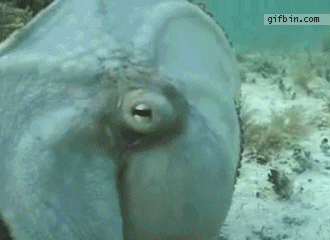 Maybe you are caught unaware. No problem, just blend into whatever looks good, like a strand of red algae:
Maybe you are caught unaware. No problem, just blend into whatever looks good, like a strand of red algae:
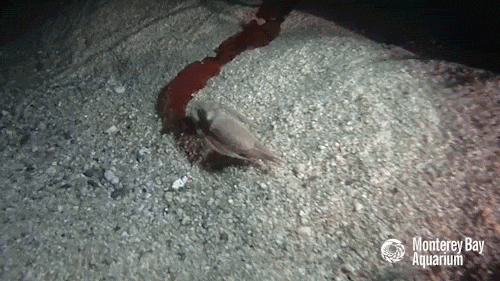 Maybe your cloak of invisibility is not enough to hide from a predator, what to do? Get really angry, very large, and look tough enough to scare them off. Bluffing is 9/10 of survival (something I learned in that Turkish prison):
Maybe your cloak of invisibility is not enough to hide from a predator, what to do? Get really angry, very large, and look tough enough to scare them off. Bluffing is 9/10 of survival (something I learned in that Turkish prison):
 Becoming invisible (or looking really pissed off) requires three simple things: (1) you will need an excellent sense of vision to relay your local environment to your brain to modify your (2) layers of stacked pigment cells called melanocytes to expand or contract, varying the color & shading of your body to re-create the color of your surroundings, and (3) relaying the physical aspect of your environment to tiny muscle fibers that instantly change to texture of your skin to mimic your substrate. Boom, gone (but still in plain sight).
Becoming invisible (or looking really pissed off) requires three simple things: (1) you will need an excellent sense of vision to relay your local environment to your brain to modify your (2) layers of stacked pigment cells called melanocytes to expand or contract, varying the color & shading of your body to re-create the color of your surroundings, and (3) relaying the physical aspect of your environment to tiny muscle fibers that instantly change to texture of your skin to mimic your substrate. Boom, gone (but still in plain sight).
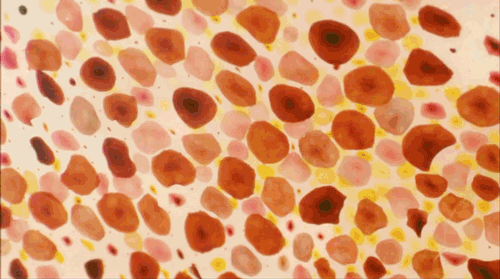
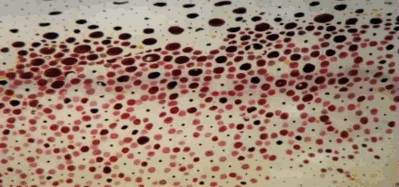 One layer of specialized cells, iridiophores, glam up the octopus with iridescent blues & greens. These aren’t pigments, but cells that contain specialized components which take in ambient light and refract only the blue spectrum. What lame-ass superhero can even bend light like that? None. Moreover, this little Blue-Ringed Octopus has some nasty venom, so the pulsing blue rings warn a potential predators, but may also be irresistable to little kids poking around in tide pools. Oops.
One layer of specialized cells, iridiophores, glam up the octopus with iridescent blues & greens. These aren’t pigments, but cells that contain specialized components which take in ambient light and refract only the blue spectrum. What lame-ass superhero can even bend light like that? None. Moreover, this little Blue-Ringed Octopus has some nasty venom, so the pulsing blue rings warn a potential predators, but may also be irresistable to little kids poking around in tide pools. Oops.
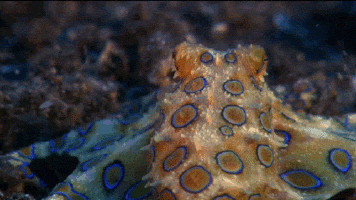
Having the superpower to flash colors & textures and immediately change shape aren’t just for fighting super-villains, but in this fast-paced world of evolution, cephalopods have come up with some excellent ways of just staying alive by a quick color change and expansion of muscles. Our friend the Mimic Octopus uses what’s called a ‘startle behavior’ in an attempt to scare off a potential predator (in this case, the underwater cinematographer):
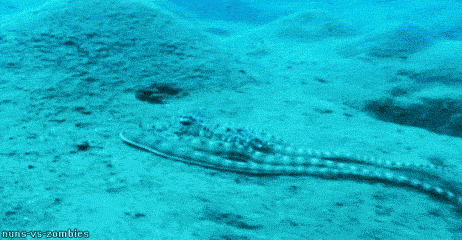 The Mimic Octopus brings up its game by using the ability to quickly change into other sea animals. Here it looks like the feathery striped fronds of the vemomous Lionfish’s fins, and the black & white banding pattern of a highly-venomous sea snake, the Banded Sea Krait:
The Mimic Octopus brings up its game by using the ability to quickly change into other sea animals. Here it looks like the feathery striped fronds of the vemomous Lionfish’s fins, and the black & white banding pattern of a highly-venomous sea snake, the Banded Sea Krait:
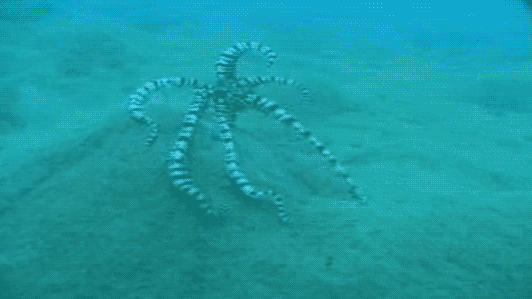
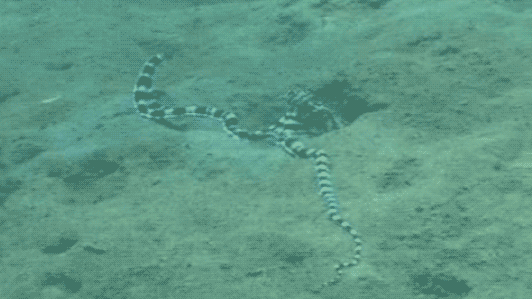
Octopus, squid, and cuttlefish all share highly muscularized tentacles, basically specially modified divisions of their boneless foot. Octopus have suckers with an impressive ability to grip, and an amazing level of fine dexterity to solve problems like this:
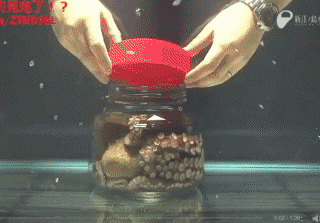 Squid tentacles may have a combination of suckers alone, or suckers with piercing hooks or sharp saw-toothed edges to grip and maim their prey, as seen in these Humboldt squid:
Squid tentacles may have a combination of suckers alone, or suckers with piercing hooks or sharp saw-toothed edges to grip and maim their prey, as seen in these Humboldt squid: 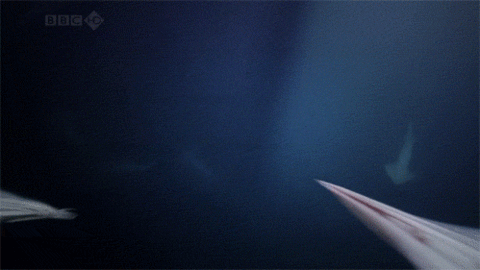 Octopus move with jets of water squirted through their siphon, and the intensity and direction of the blasts accelerates and steers the animal as smoothly as a hoverboard.
Octopus move with jets of water squirted through their siphon, and the intensity and direction of the blasts accelerates and steers the animal as smoothly as a hoverboard.
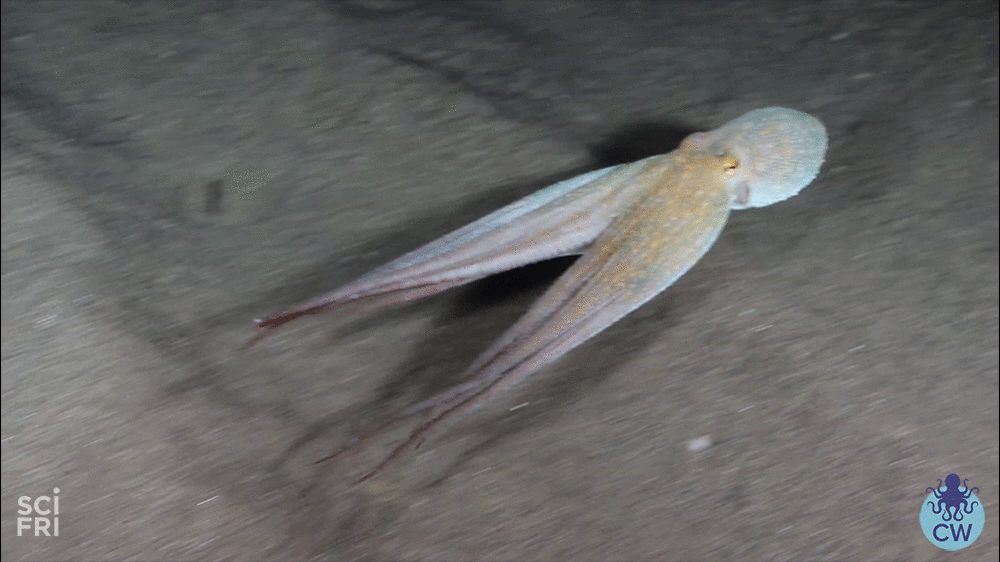 Squid aren’t that different from a personal spacecraft in those sci-fi comics, and these have a certain similarity to George Jetson‘s space car (but without George). With their siphon blasting jets of water and the fins along the side of the head undulating in waves that steer them, they can hover in place and instantaneously dart in any direction, and use their tentacles for streamlining, signaling, or attacking:
Squid aren’t that different from a personal spacecraft in those sci-fi comics, and these have a certain similarity to George Jetson‘s space car (but without George). With their siphon blasting jets of water and the fins along the side of the head undulating in waves that steer them, they can hover in place and instantaneously dart in any direction, and use their tentacles for streamlining, signaling, or attacking:
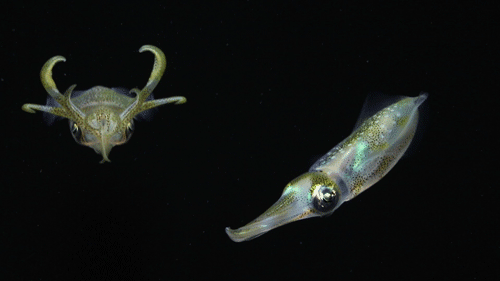 Now take this these concepts of color change, tentacles, and a personal hover-suit, and turn your little cephalopod body into some crazy disco predator. Using a neural network that coordinates the melanocytes and iridiophores into pulsating waves of light visually confuse – or possible mesmerize – prey enough to give you a split second to shoot your incredibly elastic predatory tentacles right in their face and pull them into your sharp killer beak. This is why the marine world is better than any comic book.
Now take this these concepts of color change, tentacles, and a personal hover-suit, and turn your little cephalopod body into some crazy disco predator. Using a neural network that coordinates the melanocytes and iridiophores into pulsating waves of light visually confuse – or possible mesmerize – prey enough to give you a split second to shoot your incredibly elastic predatory tentacles right in their face and pull them into your sharp killer beak. This is why the marine world is better than any comic book.
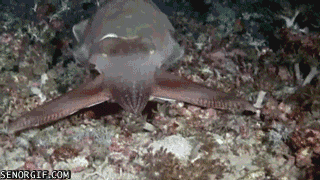 Ok, so maybe you want to be seen. You’re a hot, sexy, ripe squid with gametes a-plenty and it’s the season for love. But in the deep, dark ocean it’s hard to find the right mate. No problem, some squid have specialized bioluminescent cells in your skin where a tiny internal chemical reaction emits light energy in little glowing spots. Your species may have a special pattern that identifies the right mates for you. Not interested in love? Those same light spots may attract prey that you can feast on until the moment is right for that special copulatory embrace:
Ok, so maybe you want to be seen. You’re a hot, sexy, ripe squid with gametes a-plenty and it’s the season for love. But in the deep, dark ocean it’s hard to find the right mate. No problem, some squid have specialized bioluminescent cells in your skin where a tiny internal chemical reaction emits light energy in little glowing spots. Your species may have a special pattern that identifies the right mates for you. Not interested in love? Those same light spots may attract prey that you can feast on until the moment is right for that special copulatory embrace:
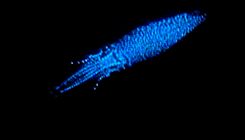
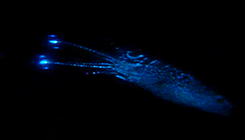
So it’s been a while since the squid love-fest, and now your life is taken up with caring for the kids. Sure, most squid just mate then dump a fertilized egg capsule on the ocean bottom and let those li’l squidlets hatch on their own, but not with Gontaus. She may not be the world’s best mom, but unlike other squid, she carries her egg mass around to protect her little brood until the time they hatch. When they do, she pulsates the eggs gently kicking them out into the big dark world below, like shaking sand off a beach blanket. Once they are out, they are on their own and she has nothing more to do with them: Again, not the greatest mom, but better than most:
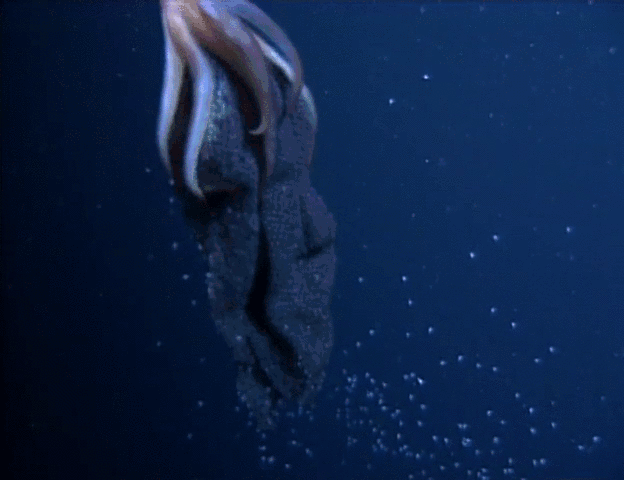
Next up, cephalopods have the highest cute factor of any invertebrate, more than flatworms, more than gastropods, and even more than those fancy-pants Peacock Spiders. I enter into evidence this contest between two little squid tucking themselves in for the night. Looking like they were designed by a Japanese toymaker, the Pyjama Squid (Sepioloidea lineolata) and the Tropical Bobtail Squid (Sepiadarium kochi) will burow into your hearts:
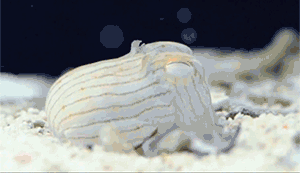
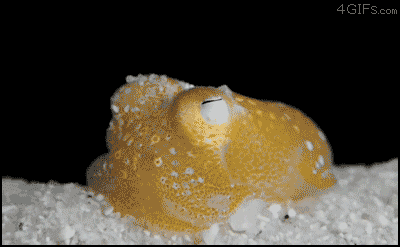 Don’t need any fancy bed because the sea floor is soft enough? Well then dig right in with a few blasts of water. No turn-down service required:
Don’t need any fancy bed because the sea floor is soft enough? Well then dig right in with a few blasts of water. No turn-down service required:
Most of all cephalopods just want to be left alone. When color changing, jetting away, burrowing into the sand, or impersonating more dangerous sea creature doesn’t work, there’s always just losing your shit and kicking ass:
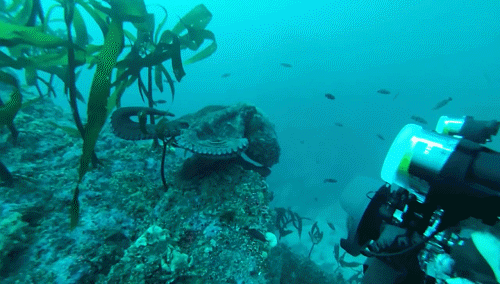


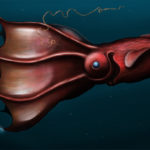
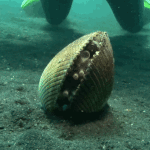
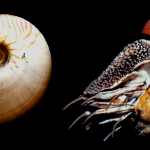
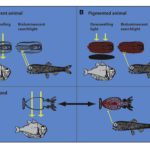
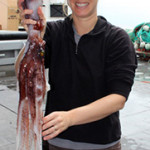
this is just fabulous, Doug.
You’ve outdone yourself with this one. Thanks!
What a throughly enjoyable article. Thank you.
I posted this on our university course web page as an xmas GIFt for my zoology undergrad class :)
We love deep sea news, especially when it’s molluscs!
Well done!